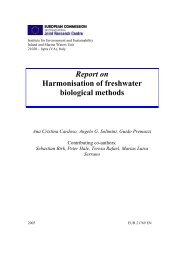Lakes and Watercourses
Lakes and Watercourses
Lakes and Watercourses
You also want an ePaper? Increase the reach of your titles
YUMPU automatically turns print PDFs into web optimized ePapers that Google loves.
TABLE 29.<br />
CURRENT CONDITIONS: potentially toxin-producing cyanobacteria<br />
Class Description Number of genera, August<br />
1 None or few ≤ 2<br />
3 A moderate number 3 – 4<br />
5 A large to very large number > 4<br />
The boundary between class 1 <strong>and</strong> 2 represents a level below which<br />
nuisance caused by water-blooming cyanobacteria does not usually<br />
occur (biomass 0.5 mm 3 /l). Other class boundaries represent approximately<br />
the 25th, 50th <strong>and</strong> 75th percentiles in that part of the background<br />
material comprising lakes having a biomass exceeding 0.5 mm 3 /l.<br />
The number of genera of potentially toxin-producing cyanobacteria<br />
indicates whether there is a short or a long-term problem in a lake used<br />
for bathing, a reservoir or a lake where fish or shellfish are farmed. The<br />
more genera found on a single sampling occasion, the greater the risk of<br />
persistent problems, since conditions for development vary from one<br />
species to another.<br />
Toxin-producing cyanobacteria are not unique to highly eutrophic<br />
lakes. They may also be found in true oligotrophic waters. As a rule, only<br />
one toxic genus is found in mountain lakes: Anabaena, which develops<br />
during a limited period of the summer season, but in other nutrient-poor<br />
lakes another genus may appear, eg, Aphanizomenon. The boundary for<br />
class 1 has therefore been set at 2 genera.<br />
The following genera <strong>and</strong> species of planktonic cyanobacteria may<br />
produce toxins in Sweden (Willén & Mattsson, 1997).<br />
Anabaena: A. circinalis, A. farciminiformis, A. flos-aquae, A. lemmermannii,<br />
A. solitaria<br />
Aphanizomenon: A. flos-aquae, A. gracile, A. klebahnii, A. yezoense<br />
Microcystis: M. aeruginosa, M. botrys, M. flos-aquae, M. viridis, M. wesenbergii<br />
Planktothrix: P. agardhii (alt. Oscillatoria agardhii)<br />
Woronichinia: W. naegeliana (alt. Gomphosphaeria naegeliana)<br />
Gloeotrichia: G. echinulata<br />
Toxic forms of Woronichinia <strong>and</strong> Gloeotrichia have not yet been<br />
discovered in Sweden, which is probably due to a lack of analysis, since<br />
their ability to produce toxins has been verified in many other countries.<br />
These two genera are more frequently found mass-developing in moder-<br />
54















![Accommodation booking form [PDF]](https://img.yumpu.com/39471785/1/184x260/accommodation-booking-form-pdf.jpg?quality=85)

